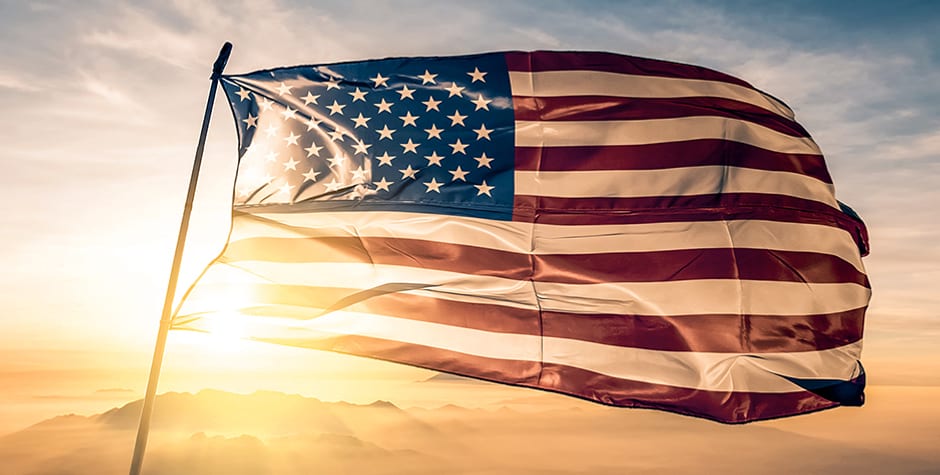Flag Day and the Importance of Symbols
June 14 is an important but little-mentioned day in the life of our nation: Flag Day. The history of the American flag is fascinating and dates back to the beginning of the War for Independence from Great Britain. Initially, there was no national banner. Regiments from the 13 colonies had their individual flags. The Second Continental Congress changed this and worked on establishing the first flag, called the Colonial Colors. However, this flag looked an awful lot like the British Union Jack. With the smoke and confusion of the battlefields, George Washington set to work, contending for a different symbol that would not confuse troops as they rallied, moved, and fought as a team in battle.
On June 14, 1777, the Second Continental Congress paused in its work on the Articles of Confederation and passed a resolution that “the flag of the United States be 13 stripes, alternate red and white” and “the union be 13 stars, white in a blue field, representing a new constellation.” In 1916 President Woodrow Wilson signed a resolution officially marking June 14 as Flag Day.
Throughout human history, people have created symbols and attached significant meaning to them. Whether ancient cave art, the markings on ancient wooden shields of various clans, the banners of the Roman legions, or many other modern representations—as humans, we relate to symbols. We are hard-wired, it seems, to connect with symbols that mark critical junctures in shared life and to symbols that unite us. And it is not only banners and art. Music is often symbolic of shared convictions and beliefs, whether it is “Hail to the Chief” played when the President of the United States enters a gathering, the National Anthem, or other compositions that have a deeper meaning.
Symbols are not without controversy. In recent years, we witnessed controversy over whether to stand for the National Anthem, especially among professional athletes. Numerous lawsuits and judicial proceedings revolve around religious symbols, especially Christian symbols, in public spaces or on government property. The Bible is frequently attacked, even though it is one of the most important symbols of the Judeo-Christian tradition and figures prominently in our nation’s history. Most elected leaders in the United States still place their hands on a Bible when taking their oath of office.
During the Vietnam era, demonstrators burned the American flag as an act of protest. The Flag Protection Act of 1968 made this illegal. Twenty years later, the Supreme Court ruled that the government violated First Amendment rights by making the desecration of a flag illegal. Yet who can forget the sight of flag-draped caskets bringing America’s warriors home or the touching scene at countless graveside services when a military honor guard folds the American flag and presents it to a family member? The flag is but one symbol that has a deeper meaning than the cloth material itself.
The lyrics of “The Star-Spangled Banner” were a poem written by Francis Scott Key as he witnessed the battle over Fort McHenry during the War of 1812. His poem was set to the tune of “To Anacreon in Heaven,” a popular British pub tune at the time. But that song has been the U.S. National Anthem since 1931. Probably no other non-religious tune evokes so much emotion. Those words and music are powerful symbols of our nation.
Why the controversy over man-made symbols? It is because of the deep spiritual and emotional connections we have to symbols. The symbol is far more than a token representation of some group of people or an event. Symbols represent the deep reality we attach to important aspects of shared life. People all over the world attach great meaning to a plethora of symbols. When a symbol is attacked, it is often perceived as a personal attack. It becomes an affront to people and to their beliefs.
Thus, we should be very reluctant to attack or denigrate symbols of the United States, no matter the rights given to us as citizens of this country. We are a nation with flaws. We have not always gotten it right in our history—though we eventually do come around in an attempt to do what is right. But symbols almost always remind us of deeply held beliefs and commitments. It is not the symbol alone that is important. Rather, it is what that symbol represents. The truths, the sacred beliefs, the shared commitment to justice and other high ideals—this is why symbols are so important.
Ironically, when a national symbol or a religious symbol is disrespected, the person launching the attack on the symbol more than likely shares a personal commitment to the very beliefs the symbol represents. It is an attack on oneself. Justice, kindness, liberty, and the rule of law—as examples—are concepts that most people embrace. But the symbol itself also represents those same ideals and beliefs. So attacking the symbol is not only personally offensive to many people—it is also contrary to the very things that unite us and call us to follow the counsel of our “better angels.”
Abraham Lincoln’s speech when our nation stood divided is still apropos as to the things that symbolize who we are as Americans:
We are not enemies, but friends. We must not be enemies. Though passion may have strained, it must not break our bonds of affection. The mystic chords of memory . . . will yet swell the chorus of the Union, when again touched, as surely they will be, by the better angels of our nature.
Happy Flag Day! It is also the birthday of the U.S. Army, founded on June 14, 1775.
Support the work of the ACLJ as we continue to bring you expert analysis and legal action on the issues that matter most.

